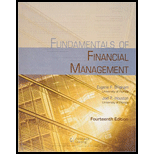
To Determine: Whether the
Introduction: Leverage is the utilization of debt by an organization to finance its operations and extension projects with an end goal to produce an return for investors. Organizations that forcefully utilize debt financing are measured profoundly leveraged and commonly riskier to invest.
Explanation of Solution
The reasons on whether the preferred stock be categorized as debt or equity and the reasons on whether the categorization is prepared by firm's administration, creditors or by the equity investors is as follows:
The preferred stock is categorized simply when the one undertaking the categorization is measured. From the point of view of the firm, preferred stock resembles equity in that it cannot compel the firm into liquidation, yet it resembles debt in that it source changes in profit accessible to the common stockholders. Subsequently, if the firm is apprehensive basically with existence, it would most categorize preferred stock as equity. Nonetheless, if there is basically no risk of insolvency or bankruptcy, the administration would see preferred stock as essentially another fixed charge bond and regard it inside as debt.
The equity investors would have a comparable perspective, and all in all they should look after the preferred stock in much indistinguishable way from debt. As far as creditors are concerned, the position is switched. They take inclination over preferred investors, and the preferred issues go about as a pad. Thus, a bond expert would likely need to regard preferred as equity. Clearly, in every one of these claims, there would need to be a few capabilities, in a stringent logic, preferred stock is either considered as a debt or as an equity, however it is considered as hybrid.
Want to see more full solutions like this?
Chapter 20 Solutions
Fundamentals Of Financial Management
- Risk associated with a particular firm’s operating conditions is which of the following risk? a.Financial Risk b.Business Risk c.Liquidity Risk d.Interest Riskarrow_forwardThe discounted cash flow is which of the following approach? a.Forward approach b.Risk approach c.Earnings approach d.Backward approacharrow_forwardexplain The risk that arises due to use of debt by the firm causing variability of return for creditors and shareholders is: a.Liquidity Risk b.Call Risk c.Default Risk d.Financial Riskarrow_forward
- 53. A fixed cash flow in each year for a specified number of years is called as……. a.Annuity b.Compounding c.Reovery Factor d.Discountingarrow_forwardWhat is the full form of "NYSE"? a.Net uield Security Exchnage b.National Stock Exchange c.Net Asset Value d.New York Stock Exchnagearrow_forwardThe method of converting the amount of future cash into an amount of cash and cash equivalents value in present is known as: a.Annuity b.Compounding c.None of these d.Discountingarrow_forward
- The risk that arises due to use of debt by the firm causing variability of return for creditors and shareholders is: a.Liquidity Risk b.Call Risk c.Default Risk d.Financial Riskarrow_forward47. The value of holding period return is always show: a.Greater than 0 b.Less than 0 c.Negative d.Equal to 0arrow_forwardCurrent yield is equal to What? a.Market yield b.Any of these c.Income yield d.Running Yieldarrow_forward
- Explain. The financial activities which are performed regularly are known as: a.Recurring Finance b.None of these c.Non-recurring finance functions d.Both a and barrow_forwardThe risk in terms of variability in security’s total return due to some exogenous factors is known as: a.systematic risk b.Unsystematic risk c.None of these d.Non diversifiable riskarrow_forwardThe Wildcat Oil Company is trying to decide whether to lease or buy a new computer-assisted drilling system for its oil exploration business. Management has decided that it must use the system to stay competitive; it will provide $3 million in annual pretax cost savings. The system costs $8.9 million and will be depreciated straight-line to zero over five years. Wildcat's tax rate is 21 percent, and the firm can borrow at 7 percent. Lambert Leasing Company is willing to lease the equipment to Wildcat. Lambert's policy is to require its lessees to make payments at the start of the year. Suppose it is estimated that the equipment will I have an aftertax residual value of $900,000 at the end of the lease. What is the maximum lease payment acceptable to Wildcat? Note: Do not round intermediate calculations and enter your answer in dollars, not millions of dollars, rounded to 2 decimal places, e.g., 1,234,567.89. Maximum lease paymentarrow_forward
- Principles of Accounting Volume 1AccountingISBN:9781947172685Author:OpenStaxPublisher:OpenStax College
 EBK CONTEMPORARY FINANCIAL MANAGEMENTFinanceISBN:9781337514835Author:MOYERPublisher:CENGAGE LEARNING - CONSIGNMENT
EBK CONTEMPORARY FINANCIAL MANAGEMENTFinanceISBN:9781337514835Author:MOYERPublisher:CENGAGE LEARNING - CONSIGNMENT  Managerial AccountingAccountingISBN:9781337912020Author:Carl Warren, Ph.d. Cma William B. TaylerPublisher:South-Western College Pub
Managerial AccountingAccountingISBN:9781337912020Author:Carl Warren, Ph.d. Cma William B. TaylerPublisher:South-Western College Pub Financial Reporting, Financial Statement Analysis...FinanceISBN:9781285190907Author:James M. Wahlen, Stephen P. Baginski, Mark BradshawPublisher:Cengage Learning
Financial Reporting, Financial Statement Analysis...FinanceISBN:9781285190907Author:James M. Wahlen, Stephen P. Baginski, Mark BradshawPublisher:Cengage Learning Cornerstones of Financial AccountingAccountingISBN:9781337690881Author:Jay Rich, Jeff JonesPublisher:Cengage Learning
Cornerstones of Financial AccountingAccountingISBN:9781337690881Author:Jay Rich, Jeff JonesPublisher:Cengage Learning





